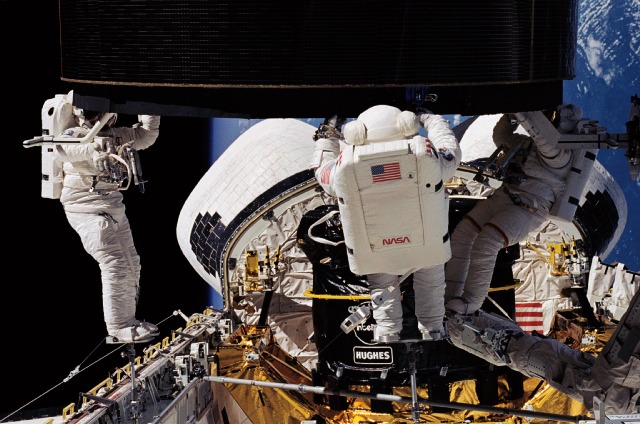
“Ready. Ready. Grab!”
The words of Rick Hieb echoed through the silent Mission Control Center (MCC) at the Johnson Space Center (JSC) in Houston, Texas.
The view through Space Shuttle Endeavour’s aft flight deck windows on the evening of 13 May 1992 was quite different from anything ever seen before. Not only was this the maiden voyage of NASA’s newest orbiter—a vehicle which, but for the loss of Challenger, might have remained a set of structural spares—but it also involved the first (and only) EVA with as many as three people. This mission, STS-49, commanded by Chief Astronaut Dan Brandenstein, had long been anticipated to be the most visible shuttle flight of 1992, but it demonstrated that human space flight retains the ability to deliver unexpected surprise. When the crew was announced, their mandate was to retrieve the Intelsat 603 telecommunications satellite, delivered into an improper orbit by a Commercial Titan III booster in March 1990. Spacewalkers Hieb and Pierre Thuot would venture into Endeavour’s payload bay to attach a new rocket motor, after which Intelsat 603 would be boosted into its 22,300-mile (35,900-km) geosynchronous orbit, ahead of its pivotal role in covering the 1992 Summer Olympics in Barcelona.
After the Intelsat activities, a further two spacewalks—the first with Kathy Thornton and Tom Akers, the second with Thuot and Hieb—would rehearse Space Station Freedom construction techniques. Thornton’s inclusion made her only the third woman, after Russia’s Svetlana Savitskaya and NASA’s Kathy Sullivan, to perform an EVA. It was a role for which she had previously trained in preparation for her first shuttle mission, STS-33 in November 1989. “I absolutely insisted that she be the EVA person,” STS-33 Commander Fred Gregory recalled in his NASA Oral History, “over great protest. If we had not insisted, probably a person of her size would never have done something like this. Kathy [Sullivan] was a larger woman who could fit into the suits, but Kathy Thornton was not, so we really had to force the issue.” Doubtless, Dan Brandenstein was in full agreement that Thornton, nicknamed “K.T.”, was the most appropriate choice. She would go on to fly as part of the EVA team which first serviced the Hubble Space Telescope (HST) in December 1993.
The other three astronauts involved in the STS-49 EVAs were male. Rick Hieb was already in training to fly STS-39 at the time the Intelsat 603 crew was assembled in December 1990, and Tom Akers had returned only weeks earlier from the Ulysses deployment mission, STS-41. The man in charge of the team—designated “EV1” and wearing red stripes around the legs of his pure-white space suit for identification—was Pierre Thuot. When he flew STS-36 in the spring of 1990, Thuot became the first of his class to be assigned a mission and the first to actually fly.
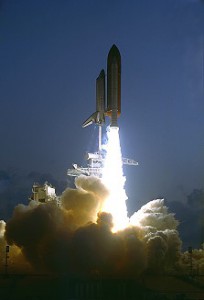
If everything ran as timelined, STS-49 would thus be the first shuttle flight to feature as many as three spacewalks and the first to include two teams of spacewalkers; both of which were critical prerequisites if NASA was to execute as many as five EVAs per mission to service the Hubble Space Telescope (HST) and build Space Station Freedom. On the face of it, retrieving and repairing Intelsat 603, for all its drama, offered something of a backward glance to the shuttle’s pre-Challenger heyday and was unusual, for in the wake of the disaster it had been mandated that the reusable orbiters would henceforth not be used for commercial missions. STS-49 was thus the last of its kind. At the same time, as Space Shuttle Program Director Bob Crippen explained in June 1990, it offered “an opportunity for expanding our experience base in the planning, training and performance of EVA” by “helping preparations for Freedom.”
Others agreed that such a mission was useful for other purposes. It was “a throwback to the good old days,” said Endeavour’s first processing manager, John Talone, “when we used to go out and do these kinds of things.” Added NASA Associate Administrator for Space Flight, former astronaut Bill Lenoir: “It’s a mission we wanted to do. It gave me the opportunity to have real work that really mattered; that was going to get measured, where we either succeeded or failed.”
In the weeks and months following the botched delivery of Intelsat 603 to orbit in March 1990, prime contractor Hughes entered into a contract with NASA, worth in excess of $90 million, for the shuttle to reboost the satellite. Two possible scenarios quickly gained prominence: either to attach a new perigee kick motor or retrieve Intelsat and bring it back to Earth for refurbishment. Concerns about the extent to which the satellite’s surfaces might degrade over two years were allayed by the test flight of several solar array sample “coupons,” attached to Discovery’s Remote Manipulator System (RMS) mechanical arm during the STS-41 mission in October 1990. These were exposed to the harsh atomic oxygen environment for a minimum of 23 hours, with few ill-effects. Two months later, in December, the STS-49 crew was named to conduct the audacious salvage.
Dan Brandenstein found himself in command of the first flight of a new shuttle and a rendezvous and retrieval mission with EVAs which promised to be filled with drama. “One of my first concerns when we first got assigned and started working with Hughes on the mission,” he told the NASA oral historian, “was if we try and grab it, if we bump it, is it going to go out of whack and float away? Part of the requirements from the customer were that we didn’t touch any sensitive area, which left you a very small ring that … had a limited accessibility and that was supposed to the way we grabbed it.”
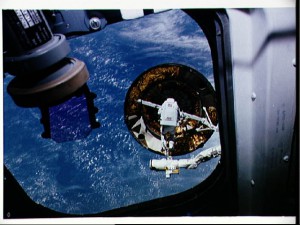
The mechanism by which Thuot and Hieb would grab Intelsat was a so-called “capture bar,” designed and built by engineers in the Crew and Thermal Systems Division at NASA’s Johnson Space Center (JSC) in Houston, Texas. Weighing 160 pounds (73 kg), it measured 15 feet (4.6 meters) long by about 3.3 feet (1 meter) wide and included detachable beam extensions and a steering wheel. As Thuot rode on the end of Endeavour’s Remote Manipulator System (RMS) mechanical arm, he would be positioned close to the base of Intelsat 603 and after grappling it would lower it delicately into a Hughes-built cradle assembly. “There was a lot of analysis done,” continued Brandenstein, “and we were assured that because it was spinning slightly and it had a lot of mass, we could bump it and it would stay pretty much in place and wasn’t going to be a problem.” Throughout 1991 Thuot and Hieb trained underwater and on the air-bearing table, to such an extent that they could follow the procedure with their eyes closed.
More than two decades ago, on 7 May 1992, the last virgin space shuttle speared for the heavens. During the next couple of days Intelsat controllers maneuvered their satellite into a “control box,” some six degrees of arc of the shuttle’s orbit. These maneuvers also served to reduce Intelsat’s rotation from 10.5 to around 0.65 rpm. By the 10th, as they approached to within 8 miles (13 km) of the satellite, Thuot and Hieb completed their procedures of suiting-up and were assisted into the airlock by crewmate Akers. Shortly thereafter, at 4:25 p.m. EDT, they opened Endeavour’s outer hatch into the payload bay—then in the pitch black of orbital darkness—and Thuot fastened himself into a foot restraint on the end of the RMS, deftly operated by veteran astronaut Bruce Melnick. Drawing closer toward the satellite, Thuot extended the capture bar into position, but the latches failed to latch.
He tried again, without success.
A third attempt was similarly fruitless.
From his station on Endeavour’s aft flight deck, Brandenstein noticed that Intelsat 603 was beginning to oscillate and drift somewhat, “so I got in my chase-it mode, because I had to keep him aligned.” When Thuot’s third attempt failed, Brandenstein had used a “tremendous” amount of propellant and instinctively knew that the chances of success were slim at best. The RMS exacerbated the difficulty, because its joints were being driven into positions which they could not support. “We decided, though consultations with the ground, to get out of there and try another day,” Brandenstein recollected. “That was a pretty low point, because when we left, it had a pretty good rate. We thought we’d lost this $150 million satellite … and Pierre was particularly depressed because, obviously, he thought it was his fault.”
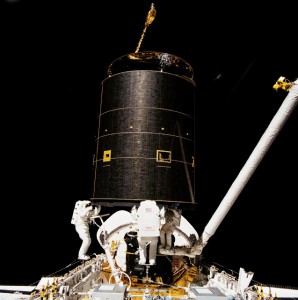
Thuot and Hieb returned inside Endeavour after three hours and 43 minutes, and later that evening Hughes engineers confirmed that they had managed to stabilize Intelsat. Next day, at 4:30 p.m. EDT on 11 May, the spacewalkers were back outside for a second attempt. “Instead of doing it at night, we were going to wait and do it in daylight,” Brandenstein said. “We decided we weren’t going to even make an attempt until everything was just perfect. Pierre went in and the rotation slowed down.” From Hieb’s position, it looked as if Thuot had completed the capture, but, alas, the satellite again began to oscillate. The astronaut’s alignment was unquestionably correct, but the capture bar refused to seat itself properly and Intelsat wobbled. A few weeks after the mission, Thuot explained to this author that the satellite “was much more dynamic than our training had led us to believe.”
As the disappointed spacewalkers returned inside the cabin for the second time—this time after 5.5 hours—they at least knew that the Hughes engineers could regain control of Intelsat 603 for another attempt. However, although propellant reserves allowed for it, three separate rendezvous on a single shuttle mission had never been attempted, and Brandenstein recommended a day off to plan for the third attempt. In an interview for the Smithsonian, Rick Hieb remembered that the evening of the 11th was a sombre time. At one point, Kevin Chilton, the STS-49 pilot and the only “rookie” member of the crew, joined Hieb on the flight deck, and the pair entered an impromptu brainstorming session. It was a session that would mark a significant turnaround in the fortunes of a mission which seemed snake-bitten.
As Hieb and Chilton talked, other members of the crew floated upstairs to join them. The main concern was where to manually grab Intelsat. The top of the satellite, where the delicate antennas were located, was not ideal, and it was Bruce Melnick who suggested an EVA with not two spacewalkers, but three. No excursion in history had ever involved more than two members, partly due to safety concerns and partly because of the sheer practicality of getting three people into the tiny airlock. On the other hand, Endeavour carried four suits for Thuot, Hieb, Thornton, and Akers, so in theory it was a possibility.
“When Bruce said that,” recalled Hieb, “a big mental switch flipped over, at least for me. In my mind, having a third set of hands out there meant that we would be successful, although we weren’t yet sure how.”
Mission Control knew that the astronauts were still awake, because Endeavour’s monitors had not been turned off. At length, the crew turned them off and continued talking in the dark, but eventually called the ground with Melnick’s idea. Years later, Brandenstein remembered that it was Chilton who sketched out the practicalities of the three-person EVA scenario and held it in front of the television camera to allow mission controllers to see it. “The big choke point,” Brandenstein said, “was can you put three people in the airlock to get them outside?” In the Houston water tank, fellow astronauts Story Musgrave, Jim Voss, and Michael “Rich” Clifford donned suits and demonstrated the techniques and geometries involved in setting themselves up to accomplish the feat.
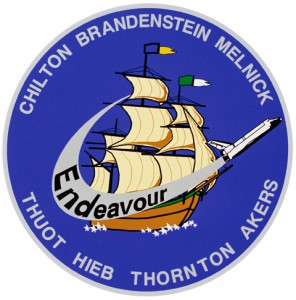
Their consensus: It was doable. On the evening of 12 May, Capcom Charles “Sam” Gemar radioed Mission Control’s approval to the crew.
Late on 13 May, the third attempt got underway. Truss members belonging to the Assembly of Station by EVA Methods (ASEM)—a Space Station Freedom demonstration payload, to be used during EVA tests later in the mission—were removed and arranged into a triangular structure for Thuot, Hieb, and Akers to anchor their feet. Brandenstein positioned the orbiter directly beneath Intelsat 603, and controllers verified that its surface temperatures would not exceed the 160 degrees Celsius (320 degrees Fahrenheit) touch limit of the astronauts’ gloves. With Hieb close to the starboard payload bay wall, Akers in the center, attached to an ASEM strut, and Thuot on the end of the RMS on the port side, the astronauts could do little but watch as Endeavour drew closer. They studied its slow rotation for about 15 minutes, until, on Hieb’s call, they moved in for the capture.
All at once, Thuot spotted a slight wobble. He called the attempt off.
Shortly thereafter, they tried again. This time, at last, the three men grabbed the satellite and held it firmly. The time was 7:55 p.m. EDT. “I actually thought the other two guys had stopped it from rotating,” Thuot said later, “so little force had I applied. Very gently, the thing came to a stop.” From the flight deck, Dan Brandenstein asked them if they had a good grasp. On Thuot’s response in the affirmative, the commander was able to advise ground controllers, with more than a hint of relief: “Houston, I think we’ve got a satellite!”
With Intelsat snared, the astronauts removed the steering wheel and installed an extension to the capture bar, which Melnick grappled using the RMS. The satellite was then positioned above its 23,000-pound (10,430-kg) Orbus-21 solid-fueled perigee kick motor, which sat vertically in its cradle. After closing four docking clamps to secure the pair, and attaching two electrical umbilicals between Intelsat and the motor itself, the spacewalkers set a pair of deployment timers and retreated to Endeavour’s airlock. Meanwhile, Kathy Thornton prepared to activate the springs to deploy the payload. At first, it did not move. “They had made a change in the wiring of the deploy system,” recalled Brandenstein, “and the change never made it through the process [and] never got into the checklist. Fortunately, somebody in Mission Control apparently knew about it. They just quick called up a different switch sequence and she did that sequence and it went.” Deployment occurred at 12:53 a.m. EDT on 14 May, and the satellite vacated the payload bay. Less than an hour later, the three spacewalkers repressurized the airlock and returned inside the cabin.
Speaking a decade or more after the flight, Dan Brandenstein regarded those few days of STS-49 as “one of those missions from hell,” and for newly-appointed NASA Administrator Dan Goldin it was truly “a baptism of fire.” Nevertheless, at 1:25 p.m. EDT on the following day, 15 May, Intelsat 603’s new motor ignited perfectly, and it was on-station in geosynchronous orbit by the 21st. As well as becoming the first shuttle crew to accomplish as many as three EVAs in a single mission—a record which they would break with a fourth excursion—the triumphant three-man spacewalk established itself as the longest in history. Their eight hours and 29 minutes outside would remain unbroken until March 2001. By now, the difficulties had prompted the Mission Management Team (MMT) to extend STS-49 by 48 hours from its planned seven-day duration. On 14 May, a record-breaking fourth EVA got underway when Akers and Kathy Thornton ventured outside for the ASEM station tests.
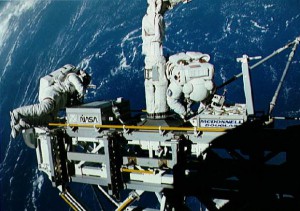
Originally scheduled to involve two EVAs—one by Thornton and Akers and the second by Thuot and Hieb—the Intelsat 603 retrieval forced the cancelation of one spacewalk.
Activities included the construction of a pyramid-shaped truss, the unberthing of a Mission-Peculiar Equipment Support Structure (MPESS)—maneuverd by the RMS—and efforts to evaluate the ability of spacewalkers to work at positions “above” and “forward” of the payload bay, including “over the nose” of the shuttle. The MPESS contained two node boxes for the pyramid, a releasable grapple fixture and interface plate, and a truss leg and strut dispenser. Five crew rescue techniques were to be trialed, including a lasso-like “astro-rope,” a seven-section telescoping pole, and a hand-held propulsive device. The latter, according to NASA’s STS-49 press kit, was “a redesigned hand-held maneuvering unit from the Skylab program,” in which pressurized nitrogen jets were employed as thrusters.
During their seven hours and 43 minutes in the payload bay, Thornton and Akers completed the construction and disassembly of the ASEM attachment fixture, tested the propulsive device, affixed six of eight legs onto the MPESS and, unexpectedly, were called upon to manually stow Endeavour’s Ku-band antenna, which had experienced a positioning motor failure. According to NASA’s post-mission report, this EVA was planned to be RMS-intensive, although the mechanical arm was used to accomplish only a single ASEM task and the spacewalkers’ timeline was further impacted by the Ku-band activity.
Returning inside Endeavour’s airlock after the excursion, the astronauts of STS-49 could now boast four EVAs—lasting a cumulative of 25 hours and 27 minutes—which had snatched success from the fangs of defeat. The physical appearance of the four spacewalkers in their snow-white suits was also quite distinct from previous missions, all of which had featured no more than two members. In order to distinguish them, Thuot (designated “EV1”) wore red stripes around his suit legs, whilst Hieb (EV2) wore a pure-white suit, and, for the first time, Thornton (EV3) wore dashed stripes around her suit legs and Akers (EV4) wore red diagonal hatches around his suit legs. In spite of the remarkable achievement of performing four back-to-back EVAs on a single mission, only relatively minor glitches plagued the spacewalkers—a failed joint on one of the portable foot restraints, a loud noise over the headsets when power tools were being used, and a battery problem, amongst others—and their suits held up exceptionally well.
In the aftermath of STS-49, the crew themselves would highlight the fact that their mission raised awareness of the need for more EVA experience in the years before the start of construction of Space Station Freedom. At one stage, in the late 1980s, as many as four EVAs per week were envisaged—an astonishing estimate which NASA Administrator Dick Truly deemed totally unacceptable. Yet as the plans for the station matured, it was obvious that the construction process would be EVA-intensive and that required different ways of working and training. “We have to take a good look at the time it takes to do a job,” Brandenstein said. “We need better ways to train so that the learning curve isn’t quite so steep.” Pierre Thuot added that the Intelsat 603 retrieval task was something that the crew “couldn’t train for fully.”
After their return from STS-49, Kathy Thornton and Tom Akers—who would go on to service the Hubble Space Telescope (HST) together in December 1993—took an active role in developing new EVA methods in the Weightless Environment Training Facility (WET-F) in Houston. “Even in the tank, you still have the resistance of water,” Dan Brandenstein recalled, “so you can kick your feet and swim. In zero gravity, we’ve got movies of Tom going to that instinct. You can see him kicking his legs and nothing’s happening. Also, if you move something in the water, as soon as you stop moving it, the reason is the water stops it. But in zero gravity, you start moving something and it just keeps moving until you come back on it. They made some significant chances in the tank training procedures.” The first flight of Endeavour’s career had gone spectacularly well and had played a significant role in shaping the missions—and the assembly of the space station—which would follow.
This is part of a series of articles to commemorate 50 years of U.S. Extravehicular Activity. Tomorrow’s article will focus on the dramatic rescue of the crippled Skylab space station by astronauts Charles “Pete” Conrad, Joe Kerwin, and Paul Weitz in June 1973.
Want to keep up-to-date with all things space? Be sure to “Like” AmericaSpace on Facebook and follow us on Twitter: @AmericaSpace
Missions » US EVAs »



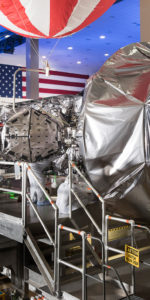
I mentioned this before, but it is worth repeating.
After the successful satellite retrieval and return to Earth, the crew presented the ASEM Team with a plaque with the acronym ASEM changed to read – Assist Someone Else’s Mission.
I believe Rick said, “Let’s do it.”